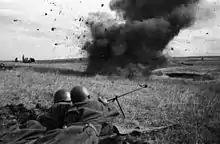PTRD-41
The PTRD-41 (Shortened from Russian, ProtivoTankovoye Ruzhyo Degtyaryova; Противотанковое однозарядное ружьё системы Дегтярёва образца 1941 года; "Degtyaryov Single Shot Anti-Tank Weapon System Model of 1941") was an anti-tank rifle produced and used from early 1941 by the Soviet Red Army during World War II. It was a single-shot weapon which fired a 14.5×114 mm round. Although unable to penetrate the frontal armor of German tanks, it could penetrate the thinner sides of early-war German tanks as well as thinly armored self-propelled guns and half-tracks.
| PTRD-41 | |
|---|---|
 Soviet soldiers with PTRD-41 defending Moscow, 1942 | |
| Type | Anti-tank rifle |
| Place of origin | Soviet Union |
| Service history | |
| In service | 1941–1960s (Retired USSR) |
| Used by | See Users |
| Wars | World War II Korean War Chinese Civil War Vietnam War[1] Syrian Civil War War in Donbass[2][3][4][5] |
| Production history | |
| Designer | Vasily Degtyaryov |
| Designed | 1941 |
| Manufacturer | Degtyaryov plant |
| Produced | 1941–45 |
| No. built | About 471,500[6] |
| Specifications | |
| Mass | 17.3 kg (38.1 lbs) |
| Length | 2020mm (79.5 in) |
| Barrel length | 1,350 mm (53 in) |
| Crew | 2 |
| Cartridge | 14.5×114mm (B-32, BS-41[7]) |
| Action | bolt-action |
| Rate of fire | Single shot,user dependent |
| Muzzle velocity | 1,000 m/s (3,281 ft/s) |
| Effective firing range | 300 m (on personnel targets, dispersion of bullets on 300 meters 0.36 m[7]) |
| Maximum firing range | 1,000 m[7] (mostly with scope) |
| Feed system | Single shot, no magazine |
| Sights | Front post, rear notch |
History

In 1939 the USSR captured several hundred Polish Model 35 anti-tank rifles, which had proved effective in the September Campaign when Poland was invaded by Germany. Vasily Degtyaryov copied its lock and several features of the German Panzerbüchse 38 when hasty construction of an anti-tank rifle was ordered in July 1941.
The PTRD and the similar but semi-automatic PTRS-41 were the only individual anti-tank weapon available to the Red Army in numbers upon the outbreak of the war with Germany. The 14.5 mm armor-piercing bullet had a muzzle velocity of 1,012 m/s (3,320 ft/s). It could penetrate an armor plate up to 35 to 40 mm (40 mm with tungsten ammunition) thick at a distance of 100 meters at 0 degrees. During the initial invasion, and indeed throughout the war, most German tanks had side armor thinner than 40 mm (Panzer I and Panzer II: 13-20 mm, Panzer III and Panzer IV series: 30 mm, Panzer V Panther (combat debut mid-1943): 40-50 mm).
Guns captured by the Germans were given the designation 14.5 mm PzB 783(r).[8]
._1941.jpg.webp)
After World War II the PTRD was also used extensively by North Korean and Chinese armed forces in the Korean War. During this war, William Brophy, an American Army Ordnance officer, mounted a .50 BMG barrel to a captured PTRD to examine the effectiveness of long-range shooting. Furthermore, Americans also captured certain number of PTRD from Viet Cong in Vietnam War. The weapon proved effective out to 2,000 yards.[9]
Users
Current
 Donetsk People's Republic: Used by pro-Russian militas in 2014.[10]
Donetsk People's Republic: Used by pro-Russian militas in 2014.[10]

Former
 Bulgaria: Equipped with 300 items (both PTRD & PTRS) by Soviet Union between 1944–1945, seen in combat operations.
Bulgaria: Equipped with 300 items (both PTRD & PTRS) by Soviet Union between 1944–1945, seen in combat operations. China: Used in Chinese Civil War, later by People's Volunteer Army during Korean War.
China: Used in Chinese Civil War, later by People's Volunteer Army during Korean War. Czech Republic: Used by 1st Czechoslovak Army Corps in the USSR.
Czech Republic: Used by 1st Czechoslovak Army Corps in the USSR..svg.png.webp) Nazi Germany: Captured and used by Wehrmacht under the title Panzerbüchse 783(r).[8]
Nazi Germany: Captured and used by Wehrmacht under the title Panzerbüchse 783(r).[8] North Korea: Equipped by the USSR, saw extensive combat in Korean War against M24 light tanks.[11]
North Korea: Equipped by the USSR, saw extensive combat in Korean War against M24 light tanks.[11] Poland: Used by 1st Tadeusz Kościuszko Infantry Division in 1943 then by other Polish divisions.
Poland: Used by 1st Tadeusz Kościuszko Infantry Division in 1943 then by other Polish divisions..svg.png.webp) North Vietnam: In stockpile, used by Viet Cong in Vietnam War.[1]
North Vietnam: In stockpile, used by Viet Cong in Vietnam War.[1] Soviet Union: Largely used in Eastern Front by the Red Army.[11]
Soviet Union: Largely used in Eastern Front by the Red Army.[11]
See also
- List of Russian weaponry
- PTRS-41
References
- "WWII German weapons during the Vietnam War". wordpress.com. 10 July 2015. Retrieved 8 December 2017./
- https://www.youtube.com/watch?v=FPtMiY96cMg&t=1107s
- Jr, Walter S. Dunn (1995). The Soviet economy and the Red Army, 1930-1945 (1. publ. ed.). Westport, Conn.: Greenwood. p. 103. ISBN 9780275948931.
- Manual on Small Arms (NSD-42) Military Publishing House Moscow 1942
- Chamberlain, Peter; Gander, Terry (1974). Anti-tank weapons. New York: Arco Pub. Co. p. 57. ISBN 0668036079. OCLC 1299755.
- "Hard Target Interdiction" (PDF). www.remingtonmilitary.com/. Remington Arms. 2005. Archived from the original (PDF) on 20 March 2006. Retrieved 13 December 2008.
- Jenzen-Jones, N.R.; Ferguson, Jonathan (2014). Raising Red Flags: An Examination of Arms & Munitions in the Ongoing Conflict in Ukraine (PDF). Armament Research Services Pty. Ltd. p. 43. ISBN 9780992462437.
- https://warfarehistorynetwork.com/daily/wwii/wwii-weapons-the-ptrs-and-ptrd-russian-anti-tank-rifles/
- Koll, Christian (2009). Soviet Cannon - A Comprehensive Study of Soviet Arms and Ammunition in Calibres 12.7 mm to 57 mm. Austria: Koll. p. 91. ISBN 978-3-200-01445-9.
External links
| Wikimedia Commons has media related to PTRD-41. |